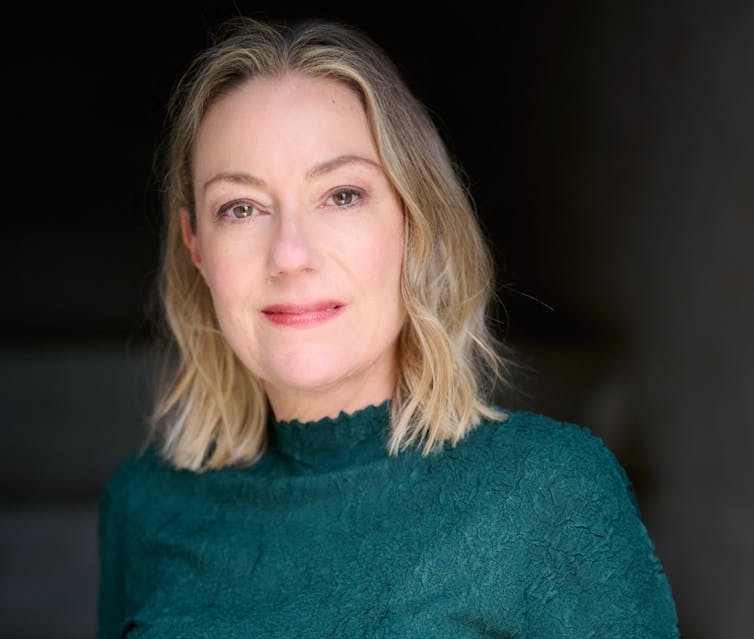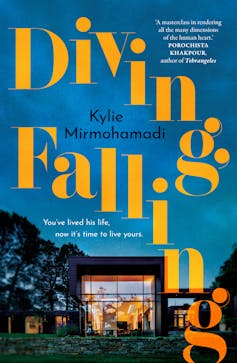“And it was Leila Whittaker, Ken Black’s widow, not Leila Whittaker the novelist who bent down to pick up a flower arrangement.”
Leila the novelist has spent a lifetime playing second fiddle to her celebrity artist husband, the evocatively named Ken Black. She strives for recognition on her own count, but her energies have clearly been sucked up in the nurturing of her husband’s art, and the raising of their two sons, the blessed Sebastian and the troubled Otis.
Review: Diving, Falling – Kylie Mirmohamadi (Scribe)
Ken’s untimely death from cancer is the starting point for Kylie Mirmohamadi’s exquisitely crafted psychological portrait of Leila: betrayed wife and numbed widow. She is also a doting mother, loyal friend and sister. But most intriguingly, she assumes a new role as lover.
Much of the novel’s narrative propulsion comes from the unfolding of Leila’s multi-faceted character. She is a complex woman on many levels.
Less happy than she ‘should be’
As a wife, Leila seems to have hardly remonstrated against Ken’s serial philandering: there are surprisingly few embittered references, even when she recognises what she assumes are the “genitals” of Ken’s muse and her former friend, Anita, wife of Ken’s agent, Giorgio. After the post-wake family dinner, Giorgio phones Leila and drunkenly proposes “we should fuck”, as revenge.
As her two adult sons become executors of their father’s artistic estate, Leila becomes a somewhat passive bystander. Decision-making about Ken’s legacy is usurped by Sebastian’s glamorous, assured partner.
Leila proves an ambiguous, slightly flaky character in other domains. Now her sons are grown, she nostalgically embraces her role as mother, but discloses that when they were young “I couldn’t be as happy as a mother, and a loved woman should be”. (To be fair, what mother wouldn’t admit to this, during those seemingly endless years of child-raising?)
Shockingly, she doesn’t challenge Ken’s physical abuse of Otis, on more than one occasion, starting in childhood when he accidentally crashes Ken’s 1971 Citroën Maserati against the garage door. From her recollections, it seems Leila regularly acquiesces in order to keep the peace. Or perhaps, more significantly, for the freedom her marriage allows to pursue her own writing and to stay in their gorgeous house, with its big glass windows looking onto the river.

I thought Leila’s somewhat ill-advised choices revealed a certain ambiguity of motive. I was never quite sure whether she really did love Ken, despite his obvious failings as husband and father. Later in the novel, she admits to loving “rich” men, in contrast to her sensible sister, Marian. Rumours of a “new Ken Black on the market” and the unearthing of new material seem to reignite Leila’s admiration for Ken, all the while minimising the significance of his more repugnant behaviours.
What did Leila value about Ken? Was it nostalgia for the heady bohemian days of their early courtship, their family life? Or was it more her love of art, and Ken’s art in particular? Or the artistic lifestyle and the accompanying wealth and prestige?
An ambivalent relationship with a long-term partner who dies in traumatic circumstances certainly complicates the grieving process, as we witness. It is fruitful subject matter for a novel, not commonly explored – lending Diving, Falling its originality and momentum. As a psychological drama, it forensically dissects complex relationships, in a fresh style devoid of clichés.
‘Waking to my own bodily rhythms’
A cover line reads: “you’ve lived his life, now it’s time to live yours.” This prompted me to expect a stronger Leila persona to emerge. At a critical point, surrounded by her poetry, her notebooks and “non internet connected laptop”, Leila does withdraw to write (yay!). We finally see some of her own naked artistic drive:
No man, no children, no dog, falling asleep when and where I wanted, and waking to my own bodily rhythms. No one’s genius to nurture, and no one’s arse to wipe.
Yet there are few insights into the metamorphosis of “Leila Whittaker the novelist”. Soon after Ken’s death, she falls for the nearest Nordic charmer, Magnus. She is also vulnerable to the seductions of the more exotic, much wealthier purchaser of one of Ken’s paintings, who happens to be married.
At one point, Leila asks herself who she is “betraying”: is it “the whole of womankind”?

At times, I was alarmed by Leila’s choices. For instance, when she invites a perfect stranger her son’s age to live with her in their Melbourne house, wanting to nurture him and his art: tiny miniature sculptures. She connects him with her favourite son, is overly attentive to his needs, announces he “should feel free to have guests in the house. Overnight ones. I was young myself once”. There is a lot of slightly cringy familiarity and boundary crossing.
At times, it seems Leila doesn’t have full insight into the choices she is making. This might be the point – grief does this. But her baffling behaviour raises the stakes, and seems intentional on Miromahadi’s part.
One possibility, though, is that Leila is finally and justifiably reclaiming autonomy in a sexual life long dominated by her husband’s needs – and the possibility of genuine love, of the kind she was denied in her marriage with Ken. I was convinced by her description of the profound experience of being loved “in a way that did not damage” her.
‘Pure art’
Throughout the novel there are plentiful references to art, mostly mediated by Leila, that will resonate with art lovers. Leila’s admiration for Ken’s art is palpable, as if the truth of it has finally become clearer in his legacy.
It was strange to see Ken’s hand in charcoal and pencil. The finer lines made his vision more sensitive somehow. It reminded me that he saw the world as we all saw it, before he took it apart and re-presented it in a way that illuminated the essence rather than reproduced the details.
Mirmohamadi’s writing was a high point for me. She is especially masterful at crafting nuance in interpersonal encounters:
I thanked Michaela as I left, and I kissed her on the cheek, and I felt her lean away. We both felt it, though I think she hadn’t meant to do it. Her body had registered threat. Her mother body and her sexual body.
Mirmohamadi touchingly renders Leila’s flaws as a mother, too. Following a poignant observation made by her less favoured son, Otis, about his recognition of this position, she says: “And that is how I can say, with confidence, that there are women walking around this earth with hearts that are broken, though they beat on.”
The prose is immersive and insightful, with layers of deep universal understandings that perhaps only art – including literature – can deliver. “Think about it, Leila. Layers of leaves, layers of truth, around the hidden heart.”
Diving, Falling is a novel about complicated grief and the unravelling of relationships following a major loss. It’s about transitions and adaptations, and new awakenings. It is also, perhaps, a manifesto about the sublimation of women’s art, in deference to the (much less hard-won) notoriety of their artist husbands. Or as about one woman’s sacrifice and eventual epiphany.
In the end, though, it is in itself like a work of art:
Like a secret language. Yes, pure art. Just to exist, not for viewing. To declare the artist’s existence. Evidence of their existence. Testimony.
Jane Turner Goldsmith does not work for, consult, own shares in or receive funding from any company or organisation that would benefit from this article, and has disclosed no relevant affiliations beyond their academic appointment.
This article was originally published on The Conversation. Read the original article.







